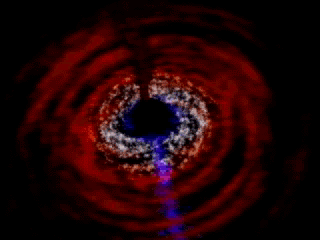How Do Massive Black Holes Grow?

Black holes up to about 50 times the mass of our Sun can be formed by normal
processes in very massive stars. This can happen throughout galaxies wherever
stars have formed recently. One way to grow a more massive black hole is for a
seed black hole in a dense galactic nucleus to swallow up gas and normal stars.
Under the right conditions, a thousand solar mass black hole can grow to
millions or billions of times the mass of the Sun in a fraction of the lifetime
of the Universe.
Alternatively, gas in a dense galactic nucleus can get so concentrated that a
supermassive star will form and evolve quickly to produce a massive black hole.
Currently, astronomers don't know whether this process or the one described in the paragraph above is the more common method for generating a massive black hole.
Many astronomers believe that most galaxies contain massive black holes. While
this assertion may well be correct, we only have evidence of massive black
holes in large galaxies - like the Milky Way or larger - and in one
dwarf elliptical galaxy: M32 in the Local Group.
Further research is needed to determine if other types of galaxies also
contain massive black holes.
| 